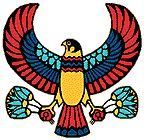



Her name means "Her life belongs to Amen"

 |
 |
|||||||||||||||||||||||||||||||
| You say Ankh-su-namum and I say Ankh-es-en-amen... | ||||||||||||||||||||||||||||||||
| OK, I had a lot to get my head round when I first looked at both films of The Mummy trying to work out what was going on with the poor girl and where they got their ideas from for both versions of Imhotep's lady love. First let me tell you about the real Ankh-es-en-anum and them I will tell you how the research looking up about her lead me to understand some other things in the remake. I am talking especially about that strange line Jonathan uses to control the soldier mummies. Intregued? Well so was I when I worked this out so read on ... | ||||||||||||||||||||||||||||||||
 |
||||||||||||||||||||||||||||||||
| Ankh-es-en-amun like Imhotep did really exist,although she turns up in history a little later, ten centuries later in the 18th Dynasty. Ankh was daughter of Amenhotep IV (also known as Amenophis IV or Akhenaten as I will explain later) and Nefertiti. She was the wife of Tut-ank-amen, apparently the marriage was a love match and the picture of the two here shows some of the art that was produced during their lifetime showing the devoted pair together. Tut-ankh-amen's tomb is full of similar things. Unfortunately their time together was not to last, King Tut died of a massive head wound- modern archaeologists think he was murdered - and Ankh-es-en-amun was left to marry his successor until she disappeared, probably murdered too. There is a rather touching letter that exists which she sent to one of the kings of a neighbouring country asking him to send her a son to marry. She said otherwise she would have to wed a servant and in the end she did marry Ay who was her late husband's visier. | ||||||||||||||||||||||||||||||||
 |
||||||||||||||||||||||||||||||||
| The Cartouche here contains Ank-es-en-amun's name. Her name means "Her life belongs to Amen" |
||||||||||||||||||||||||||||||||
| Ankh-en-es-amun and Ankh-su-namun are just different pronunciations of the same name so it seems that the two films are using the same girl, which is not quite correct. While the 1932 film probably used the name because of the Tut-ankh-amen link they did at least tell us she was the daughter of Amenophis and I will explain the details about this later. The problem is that the remake prologue happened in the 19th Dynasty when Seti was on the throne and so Ankh-su-namum although she holds the same name there is nothing to do with the real girl. | ||||||||||||||||||||||||||||||||
| Now to explain about Amenophis aka Amenhotep aka Ahkhenaten. His image graces the top of these pages if you are interested to look at the face of the man. Amenophis is the Greek version of Amenhotep so they are one in the same; Akhenaten is a name Amenhotep IV adopted later in his life, as I will explain. The Amenhotep who we are talking about, the real Ankh-su-namun's father is quite interesting and is involved in one of the more famous occurrences of Egyptian history. This was because as Akh-en-aten he tried to bring monotheism - the idea of there being one god - into Egypt and managed for a time removing all the gods in the Egyptian pantheon and replacing them with worship of the one god Aten the sun disc. The King even changed his name, Amenhotep means 'Amen-Ra is satisfied' while Akh-en-aten means 'The glory of the Aten'. Once normality had been restored to Egypt in future years he was known as the 'Great Blasphemer' for even thinking about doing this. Interestingly it has been suggested that Amenhotep had Joseph (who we know from the Bible) as his tutor and so grew up with these ideas. | ||||||||||||||||||||||||||||||||
| Amenophis may be a name which is familiar to you from the film and to find out about this go to his page on the People Pages at the link below. | ||||||||||||||||||||||||||||||||
| People pages | ||||||||||||||||||||||||||||||||
| home | ||||||||||||||||||||||||||||||||
 |
||||||||||||||||||||||||||||||||